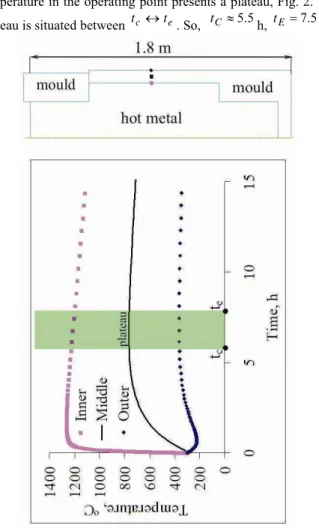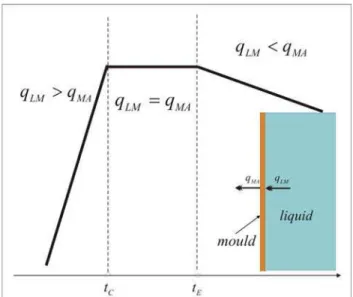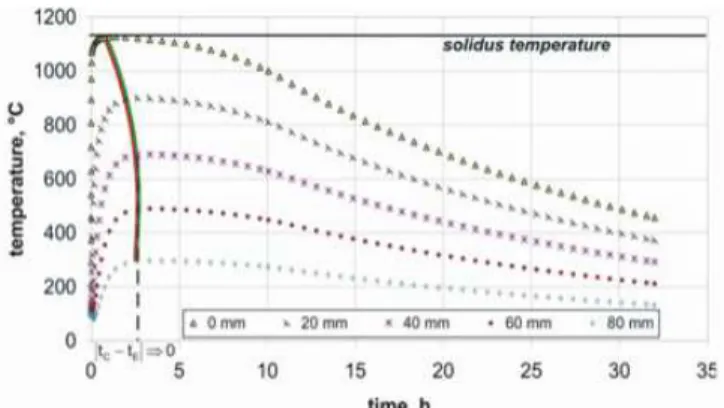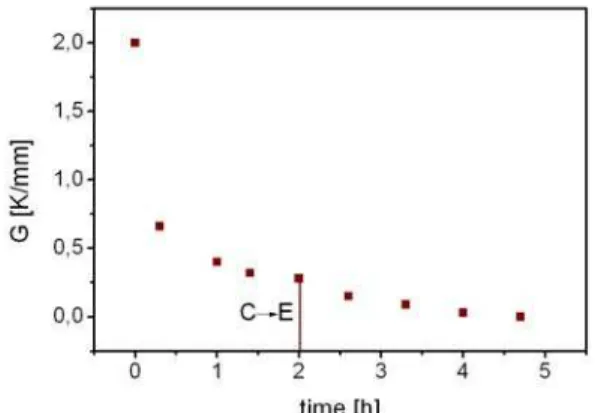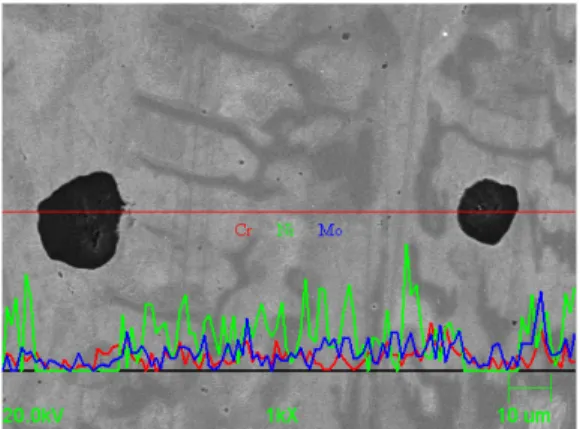A R C H I V E S
o f
F O U N D R Y E N G I N E E R I N G
Published quarterly as the organ of the Foundry Commission of the Polish Academy of Sciences
ISSN (1897-3310)
Volume 9
Issue 4/2009
254 – 260
47/4
Interplay between temperature gradients field
and C
Î
E transformation in solidifying rolls
W. Wo
ł
czy
ń
ski
a*, E. Guzik
b, B. Kania
c, W. Wajda
a aInstitute of Metallurgy and Materials Science, Polish Academy of Sciences , Reymonta 25, 30-059 Kraków
b
Faculty of Foundry Engineering, AGH University of Science and Technology, Reymonta 23, 30-059 Kraków
c
Faculty of Physics, AGH University of Science and Technology, Reymonta 19, 30-059 Kraków
*Corresponding author. E-mail address: nmwolczy@imim-pan.krakow.pl
Received 01.07.2009; accepted in revised form 07.07.2009
Abstract
At first step of simulation a temperature field for solidifying cast steel and cast iron roll has been performed. The calculation does not take
into account the convection in the liquid since convection has no influence on the proposed model for the localization of the CÎE
(columnar to equiaxed grains) transformation. However, it allows to study the dynamics of temperature field temporal behavior in the
middle of a mould. It is postulated that for the CÎ E transition a full accumulation of the heat in the mould has been observed (plateau at
the T(t) curve). The temporal range of plateau existence corresponds to the incubation time for the full equiaxed grains formation. At the second step of simulation temporal behavior of the temperature gradient field has been studied. Three ranges within temperature gradients field have been distinguished for the operating point situated at the middle of mould:
a/ for the formation of columnar grains zone, (T&>>0 and high temperature gradient ∂T/∂rt<tC −∂T/∂rtC >>0),
b/ for incubation of the liquid to the C Î E transformation, (T&=0 no temperature gradient changes ∂T/∂rtC −∂T/∂rtE≈0),
c/ for equiaxed grains growth, (T&<0 and moderate temperature gradient ∂T/∂rtE−∂T/∂rt>tE >0). T - temperature, r - roll radius.
It is evident that the heat transfer across the mould decides on the temporal appearance of incubation during which the solidification is significantly arrested and competition between columnar and equiaxed growth occurs. Moreover solidification with positive temperature gradient transforms into solidification with negative temperature gradient (locally) after the incubation. A simulation has been performed for the cast steel and cast iron rolls solidifying as in industry condition.
Since the incubation divides the roll into to parts (first with columnar structure, second with equiaxed structure) some experiments dealing with solidification have been made in laboratory scale.
Finally, observations of the macrosegregation or microsegregation and phase or structure appearance in the cast iron ingot / roll (made in laboratory) has also been done in order to confront them with theoretical predictions. An equation for macrosegregation identification is suggested. Additionally, a new equation for redistribution studied across a given grain and its surrounding (precipitates) is also delivered. The role of the back-diffusion parameter is emphasized as a factor responsible for homogenization of the massive roll ingots.
1. Introduction
Roll ingots made of steel, cast steel or cast iron belong to the kind of tools for which a very high requirements are applied. It is justified because the rolls are very expensive tools. That is why some producers are in co-operation with the adequate research laboratories.
The materials from which roll ingots are to be resistant to abrasive wear, mechanical and thermal fatigue as well as to crack propagation.
The chemical composition of the rolls are imposed by the mandatory standards. However, some foreign companies like AKERS, SFR (Sheffield Forgemaster Rolls) GOSWIG or Slevarny Trinec offer rolls with another combination of chemical elements among which the most important are: C, Si, Cr, Ni and Mo. The amount of each element in a given alloy determines its cost and production economy.
The current work makes an attempt at finding correlation
between temperature gradients field and a CÎE transformation in
order to optimize structure of the rolls and their properties.
CÎE (columnar grains into equiaxed grains) transformation
has already been discussed in a fundamental way by Hunt [2].
2. Simulation of the temperature field
in solidifying massive roll
A simulation of the temperature field has been made for the imposed geometry of roll but without convection. It was assumed that convection does not have an effect on value of temperature at the middle-point located in the mould.
Commercial Finite Element software ABAQUS was used for simulation of a temperature field behaviour. To calculate the temperature field basic energy balance has been considered:
∫
=∫
+∫
V S V
dV dS q dV
U σ
ρ &
(1)
The heat flux follows the Fourier law expressed as:
x /
q=−λ ∂θ ∂ (2)
The boundary conditions assumed in the performed simulation are shown in Fig. 1.
Fig. 1. Geometry of temperature field (for a roll) and applied boundary conditions
V – material volume, S – surface, ρ - material density, U
- time rate of the internal energy of the liquid/solid system, q –
heat flux per unit area of studied material,
&
σ – latent heat λ–
conductivity matrix (the isotropic matrix), x– position, – heat
transfer coefficient, – external temperature.
h
0
θ
For more detail of the temperature field description see ABAQUS Theory Manual [1].
The calculations were performed on the computer located at the Academic Computer Centre CYFRONET – AGH (computer named “BARIBAL”, was financed from the research project MNiSW/SGI3700/PAN/021/2009).
2.1. Operating point of the temperature field
It has been postulated that the middle-point in the mould is the representative place for the calculated temperature field., Fig. 2. This point has been named as operating point of the temperature field for the solidifying roll. Really, the temporal changes of temperature in the operating point presents a plateau, Fig. 2. The
plateau is situated between tc↔te. So, tC ≈5.5h, tE =7.5h.
Therefore, the most interesting is to analyse the temperature field
determined for time tC and tE distinguished in Fig. 2 as tc, te.
Fig. 3. Temperature field as calculated for both times: tC and tE
A comparison of temperature field created at 5.5 hour of solidification progress and that at 8.0 hour indicates that practically temperature field is not changed significantly. The only decrease of temperature is associated with the sedimentation cone situated at the bottom of roll, Fig. 3b. So, it can be
concluded that within the range tC ↔tE growth of the crystals
occurs with moderation. A disappearance of columnar crystal and first appearance of equiaxed crystal could be observed. It can be
concluded that period of time is the time for coexistence
of both types of crystals. The period of time is the time
for the studied CÎE transition.
E C t t ↔ E C t t ↔
Thus, at the - time oriented dendrites completed their
growth and equiaxed dendrites started to be growing at the time
with the presence of negative temperature gradients (locally) and moderate positive temperature gradients (in whole roll volume).
C
t
E
t
2.2. C
Î
E transition in the solidifying rolls
The C Î E transition was already discussed by Hunt [2].
According to Hunt’s predictions the C Î E transition occurs at
certain range of temperature gradients which is not defined precisely. The only suggestion given by Hunt [2] is how to predict
a critical temperature gradient, at the s/l interface , at which
the so-called fully equiaxed growth occurs.
.
crit
G
(
)
[
N C]
Ccrit I T T T
G .<0.617 01/31− Δ /Δ 3 Δ (3)
0
I
- total numbers of the heterogeneous substrate particles originally available per unit volume of the liquid phase,
N
T
Δ - undercooling at the real heterogeneous nucleation
temperature,
C
T
Δ
- undercooling equal to that of the columnar growth interface temperature.
Fig. 4. Scheme of temperature field versus time for an operating
point defined in Fig.2, (casting steel): a/ below , , b/
within
C
t T&>>0
E
C t
t ↔
, T&=0, ∂T/∂rtC≈∂T/∂rtE , (Fig. 3), for all
values of roll radius, and c/ above the time , . The
interplay between heat fluxes ( liquid mould and
mould air) described for three discussed time periods
E
t T&<0
LM
q → qMA
→
2.3. Analysis of temperature gradients field
A calculation of the temperature field allowed to create the temperature gradients field for three studied periods of time that is
for: t<tC, tC≤t≤tE and t>tE.
It is suggested that temporal changes of the temperature gradients field also conform to the above mentioned periods of time distinguished in Fig. 2 and shown schematically in Fig. 4.
Therefore, a temperature changes at different points situated in the mould have been calculated and shown in Fig. 5
It is postulated that only middle point in the mould is neutral for heat transfer (no influence of air nor liquid cast iron) and this
point is representative for defining the period of time.
Therefore, the middle point has been distinguished in Fig. 5 to
define e c t t ↔ E C t t ↔
period for CÎE transformation during which
Fig. 5. Changes of temperature versus time at different points situated in the mould as calculated for a middle massive roll made of cast
iron. Intersection of vertical curves with temperature profile printed for middle point of mould defines the period of time tC↔tE
Fig. 6. Periods of time (distinguished zones) referred to the formation of different types of structure in the solidifying roll
Additionally, a difference of the temperature observed just at the mould / ingot interface has been calculated and drawn in function of time during which the roll was solidifying.
The mentioned difference has been taken into account for two neighboring meshes situated at the mould / ingot interface as it results from numerical treatment of the heat transfer , Fig. 6.
Some inflexion points observed along the curve printed in Fig. 6 allow to distinguish three general zones for solidifying roll: chilled grains zone (zone 1), zone of the columnar grains accompanied by two types of the eutectics (zone 2) and zone of equiaxed grains also accompanied by two types of the eutectics (zone 3).
Moreover, it is suggested that characteristic points on the analysed curve allow also to distinguish temporal boundary between grains and eutectics appearance.
The temperature field calculated for solidifying roll in function of time yields the field of temperature gradients. Fig. 7 shows the temperature gradients field for time equal to 1.4 h.
Fig. 7. Temperature gradients versus roll radius. Vertical line denotes the position of liquidus temperature. The temperature
gradient at the tip of growing columnar dendrite is G=3.2
[K/cm]
Fig. 8. Temperature gradients versus roll radius. Vertical lines denote the positions of liquidus and solidus temperature, respectively. The temperature gradient at the tip of growing
columnar dendrite is G=1.5[K/cm]
All the values of temperature gradients in the liquid calculated for tips of growing dendrites are gathered in Fig. 9.
It is postulated that the transition CÎE can be observed for
time equal to 2.0 hours according to the behavior of the localization of calculated points shown in Fig.9.
Fig. 9. Temperature gradient calculated for the tips of growing
dendrite (for liquidus(N0)versus time of roll solidification Two tendencies could be distinguished according to the behavior of temperature gradients drawn in Fig. 9. At first, temperature gradient decreases significantly for the period of time contained between beginning of solidification until 2 [h] the process under investigation. Next, the temperature gradient is also decreasing, but slowly, Fig. 10.
Fig. 10 Tendencies in the behavior of temperature gradients The
boundary between tendencies indicates the time for CÎE
transition.
Therefore, the temperature gradients for the postulated beginning
of the CÎE transition have been calculated and shown in Fig. 11.
Fig. 11 Temperature gradients versus roll radius. Vertical lines denote the positions of liquidus and solidus temperature,
respectively.
3. Solute redistribution in solidifying
massive roll
Not only temperature gradients field can be related to the different structure formation (columnar or equiaxed zone), Fig. 1 – Fig. 11 but the direct observations of structure can be associated with the solutes segregation or redistribution as well. Therefore, some initial measurement of solutes redistribution are shown in Fig. 12, Fig. 13.
Fig. 12. Morphology of the cast iron roll revealed at 3 mm from the roll surface. Black particles – nodular graphite, dark areas –
cementite, bright areas – austenite. Small particles of nodular graphite are also visible inside the dendrite. The phenomenon of graphite particles enveloping by austenite has been revealed and
explained, [6-7]
Fig. 13. Morphology of the eutectic grains (nodular graphite enveloped by austenite, dark areas–cementite, bright areas– austenite. Small particles of nodular graphite are also visible
inside the dendrite
Since the nodular graphite was obtained in the roll structure, a solutes redistribution was measured along the distance between particles, Fig. 12. It makes possible to confront the result of measurement with theoretical predictions.
Therefore, the following theoretical equation describing solute redistribution is proposed, [3]:
(
x,X0,α)
[
k β( ) (
x,X0 β X0,α)
]
N( )
x,αNB = + ex in L (4)
x - amount of growing crystal, dimensionless,
0
X
x= amount of crystal at which solidification is arrested and
morphology frozen,
k- partition ratio,
α - back-diffusion parameter defined in [4],
ex
β - coefficient of the redistribution extent,
in
β - coefficient of the redistribution intensity,
L
N
- solute concentration in the liquid measured at the liquidus line.
The above equation is universal one and can be applied to the study of solutes redistribution in both types of morphology columnar (2D) and equiaxed (3D).
Macrosegregation analysis is also possible because the solutes redistribution was measured at different distances from the roll axis. Therefore, a determination of macrosegregation maps is possible. The macrosegregation can be described by an index of macrosegregation defined as follows:
0 min max
. [N N ]/N
imacr = B − B
(5)
max
B
N
maximum solute concentration at a given area of the roll,
min
B
N
minimum solute concentration at a given area of the roll,
0
N
nominal concentration of a solute in the studied cast iron.
4. Concluding remarks
The performed simulation of the temperature field for solidifying roll allows to conclude that:
• CÎE transformation occurs approximately at 2.0 hours of
solidification progress for a given cast iron roll of an imposed geometry, Fig. 9, Fig. 10,
• a middle point of the mould is a good operating point for the
analysis of the CÎE transformation,
• the plateau for temperature versus time curve is observed for
both cast steel, Fig. 2 as well as for cast iron, Fig. 5 but in the
case of cast iron tC−tE →0,
• CÎE transformation is recorded at the operating point at
2.5 hours of solidification progress for a given cast iron roll of an imposed geometry, Fig. 5, Fig. 6,
• a difference between temporal localization of CÎE
transformation (as it results from a comparison of both Fig. 9, Fig. 10 with Fig.5, Fig.6) yields from the delay of heat transfer between moving solid/liquid interface and operating point,
• a study of temperature gradients field created within a
solidifying roll can be also used in estimating of the CÎE
transformation, Fig.2, Fig. 4, Fig. 5, indirectly and Fig. 9, Fig. 10, directly,
• generally, three ranges within temperature gradients field can
be distinguished while analyzing temporal behavior of the operating point, Fig. 2, Fig. 4, Fig. 5:
a) for the formation of columnar grains zone,
(T&>>0 and high temperature gradient
∂T/∂rt<tC −∂T/∂rtC >>0),
b) for incubation of the liquid to the C Î E
changes ∂T/∂rtC −∂T/∂rtE≈0),
c) for equiaxed grains growth, (T&<0 and moderate temperature gradient∂T/∂rtE−∂T/∂rt>tE >0).
• when the so-called plateau is observed then a stationary flux
of heat from the ingot towards the mould should be expected,
• the envisaged flux is steady-state flux because of the full
accumulation of the heat in the mould during the tC ↔tE
period of time,
• the problem of the behavior of temperature gradients field is
discussed for the massive rolls and middle massive rolls
solidification thus aα- back-diffusion parameter, (Eq. (4))
tends towards unity,
• when the back-diffusion parameter is closed to unity then
full homogenization of grains can be expected,
• moreover, full homogenization of the grains is accompanied
by the solution of non-equilibrium eutectic precipitations.
Acknowledgements
The article is dedicated to Professor Wojciech Kapturkiewicz, our Dear Colleague and Respected Scientist in the area of the description of transport phenomena
The financial support from the Polish Ministry of Science and Higher Education (MNiSW) under contract N R15 006 004 is gratefully acknowledged.
References
[1] ABAQUS Theory Manual, The Academic Computer Centre CYFRONET – AGH.
[2] J.D. Hunt, Steady State Columnar and Equiaxed Growth of Dendrites and Eutectics, Materials Science & Engineering, Vol. 65, (1984) 75-83.
[3] W. Wołczyński, Back-diffusion Phenomenon During Crystal
Growth by the Bridgman Method, chapter 2. in the book: Modelling of Transport Phenomena in Crystal Growth, eds. J.S. Szmyd and K. Suzuki, ed. WIT Press, Southampton - Boston, 2000,19-59.
[4] H.D. Brody, M.C. Flemings, Solute Redistribution in Dendritic Solidification, AIME Transactions, Vol. 236, (1966), 615-623.
[5] W. Kapturkiewicz, Modelowanie krystalizacji odlewów
żeliwnych. Monografia AGH Vol.2, (2003). Wydawnictwo
Naukowe AKAPIT–Kraków.
[6] E. Fraś, M. Górny, H.F. Lopez, Eutectic Cell and Nodule
Count in Cast Iron. Part I. Theoretical Background. Iron and Steel Institute of Japan. Vol. 47, (2007), 259-268.
